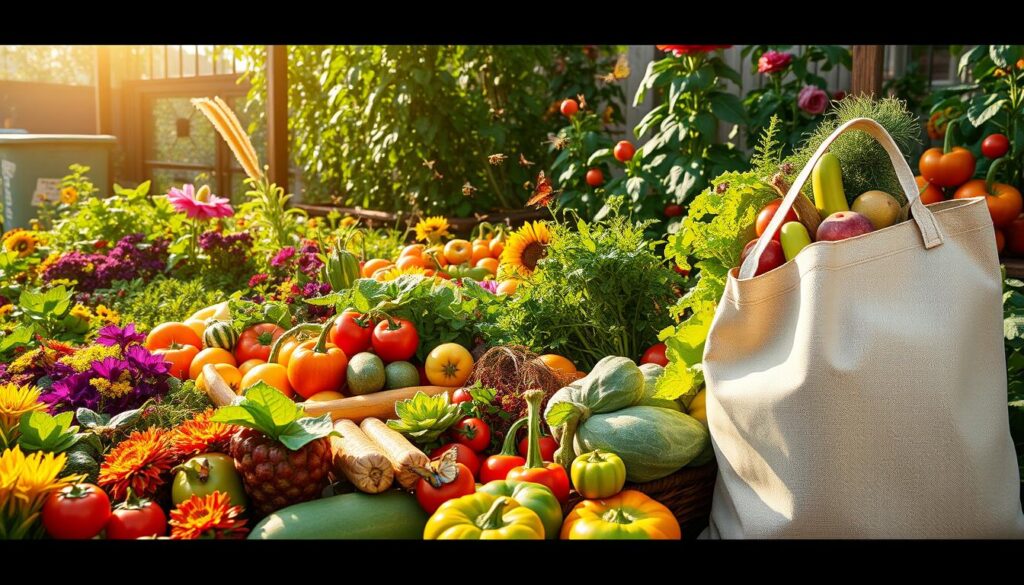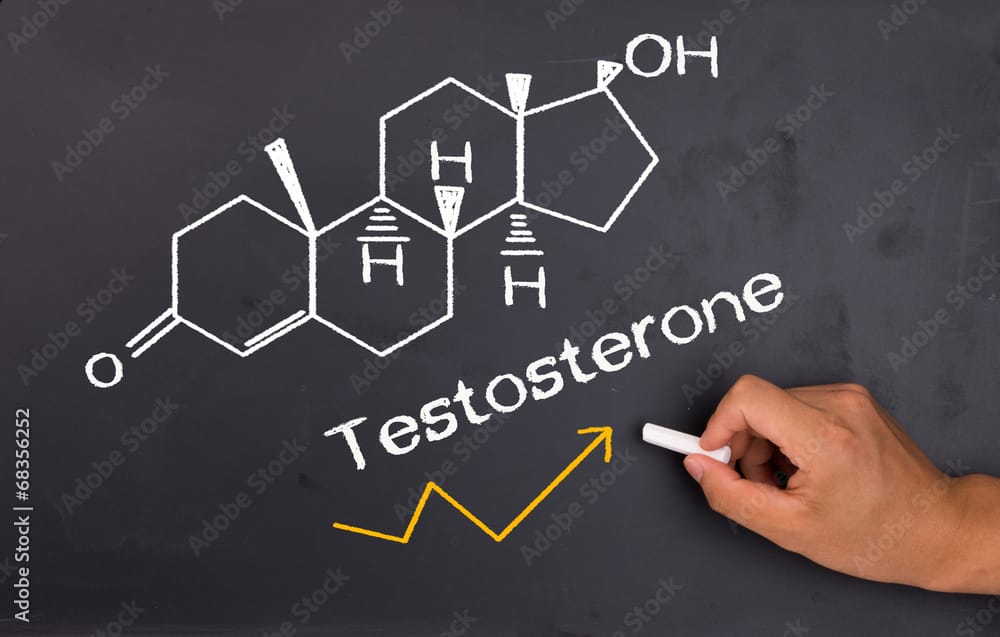Ever thought about how your food might hurt the planet? The way we produce food is harming our environment. It’s time to switch to sustainable diets for our health and the Earth’s.
Did you know over 820 million people don’t have enough food? Yet, unhealthy diets are more dangerous than drugs and unsafe sex together1. This article will show how we can eat better for our health and the planet.
Let’s learn about eating right. We’ll focus on more plant-based foods and less animal products. We’ll find ways to eat healthy for a greener future.
Key Takeaways
- Sustainable diets require doubling the consumption of fruits and vegetables while halving red meat and sugar intake by 2050.
- Over 820 million people lack sufficient food, highlighting the disparity in food distribution despite overall food production.
- Unhealthy diets increase the risk of mortality more than unsafe sex and substance use combined.
- A substantial percentage of greenhouse gas emissions comes from agriculture, particular methane.
- Shifting to plant-rich diets can enhance health outcomes and environmental sustainability.
- Food waste is a pressing issue, with 30%-40% of produce going to waste in the U.S. each year.
Introduction to Sustainable Diets
Learning about introduction to sustainable diets can improve our health and the planet. The 2005 Giessen declaration showed how our food choices affect us and the environment2. Now, many seek eco-friendly food choices that are good for the planet. In 2012, the FAO report outlined four key areas of sustainable diets: health, economics, culture, and the environment2.
Small, smart changes can make us and the planet healthier. For example, nutrient density is key, showing how much nutrition we get per 100 calories2. Nutrient-rich foods are often pricier and have a bigger environmental impact2. Also, eating fewer calories can reduce greenhouse gas emissions, showing the importance of mindful eating2.
There are many resources for learning about sustainable diets. A 2-hour course on Sustainable Diets by Danone is available online3. There are also four short videos on sustainability issues3. The United Nations Environment Program has a video on food system challenges3. These tools connect healthy eating with sustainability, providing knowledge and actions for better food choices.
Understanding the Importance of Sustainable Diets
The need for sustainable diets is growing as we tackle big health and environmental issues. Our food systems are a major source of greenhouse gas emissions. Sadly, only a few hundred out of thousands of food crops are used today4. This means we rely heavily on just nine crops for most of our food, making us vulnerable to food shortages.
Also, many people in richer countries eat too much meat and animal products, harming their health and the planet4. Foods from plants are better for the environment than animal products. This shows we can eat healthier and reduce our impact on the planet4.
We need to get more people to eat diverse and sustainable diets. It’s important for at least half of the world to change their food guidelines in the next ten years4. Choosing sustainable foods can help save forests, improve water and soil, and cut down on pollution4.
What is a Sustainable Diet?
A sustainable diet meets nutritional needs and considers the environment. It focuses on foods that are good for us and the planet. This means eating more plant-based foods like vegetables, fruits, and whole grains.
These foods are low in bad fats and high in antioxidants. Studies show that eating this way can prevent diseases and help the environment.
Defining Nutritional Needs
Everyone’s nutritional needs are different. Sustainable diets aim to avoid vitamin and mineral deficiencies. They suggest eating a variety of foods to meet individual health needs.
People often choose foods based on health, naturalness, price, and social aspects. This shows how important diet is for our health5. Sustainable diets also try to reduce environmental harm while avoiding nutrient excesses6.
Environmental Impact of Food Choices
Food production has a big impact on the environment. It’s responsible for about 30% of global greenhouse gas emissions. Livestock is a big part of these emissions5.
The livestock sector also uses a lot of land, taking up about 40% of global land5. As the world’s population grows, we need to change our food system. We should eat less red meat and sugar, and more fruits, nuts, vegetables, and legumes5.
These changes can reduce the environmental harm of food production. They help keep our planet balanced.
The Benefits of Plant-Based Meals
Plant-based meals offer many benefits for our health and the environment. Eating more plant-based foods can make us healthier and help the planet. Studies show that these diets can lower the risk of chronic diseases, which is important given the high obesity rates worldwide7.
Health Benefits
Plant-based meals are good for our health. They can help us lose weight and reduce the risk of diseases like cancer and heart disease8. Eating more plants can also improve our insulin sensitivity and how our body handles food after eating9. This can lead to a healthier lifestyle overall.
Environmental Advantages
Our food choices affect the environment a lot. Animal farming is a big source of pollution and uses a lot of land7. Choosing plant-based meals can reduce our carbon footprint and help nature9. It also saves water, as raising animals uses over half of our freshwater7. The EAT-Lancet Commission says we need to eat more sustainably for our health and the planet’s9.
| Health Indicator | Plant-Based Diet | Traditional Meat-Based Diet |
|---|---|---|
| Risk of Obesity | Lower | Higher |
| Risk of Type 2 Diabetes | Lower | Higher |
| Heart Disease | Reduced risk | Increased risk |
| Environmental Impact | Lower emissions | Higher emissions |
In summary, choosing plant-based meals is good for us and the planet. It helps us stay healthy and supports a sustainable future798.
Sustainable Diets and Their Role in Climate Change
Food production is a big part of climate change, making up about a third of all greenhouse gas emissions. The main culprits are agriculture and land use, like methane from cows and nitrous oxide from fertilizers10. Switching to sustainable diets can greatly help our planet. For example, eating more plants can cut down emissions by up to 84% in rich countries11.
Animal-based foods, like red meat and dairy, are the biggest polluters10. On the other hand, plant-based foods are better for the environment and our health. They help lower emissions and match dietary guidelines that can cut down health risks12.
Reducing food waste is also key in fighting climate change. Almost 1 billion tons of food are thrown away each year, causing over 8% of global emissions10. By making better food choices, we can tackle climate change and ensure a sustainable future for everyone.
The Environmental Impact of Food Production
Food production has a big impact on the environment. This includes greenhouse gas emissions and water usage in farming. Our food choices affect the planet a lot.
Greenhouse Gas Emissions
Food systems cause about one-quarter (26%) of global greenhouse gas emissions. This shows we need to act fast13. Farming uses about 70% of global freshwater, making food production less sustainable13.
Meat and dairy diets use more resources than plant-based ones. This adds to greenhouse gas emissions14. In the U.S., a meat-based diet emits three times more than a vegetarian one and six times more than vegan14.
Water Usage Concerns
Water use in farming is a big worry. About 70% of global freshwater is for farming, putting a lot of pressure on our water13. Meat and dairy production use a lot of water, making water scarce in some areas.
Agriculture causes 78% of ocean and freshwater pollution. This shows how food production harms the environment13.
Key Components of a Balanced and Sustainable Diet
I think making a balanced sustainable diet is key for health and the planet. By focusing on certain foods, I can eat better and help the environment. Whole grains and lots of fruits and vegetables are at the heart of this diet.
Emphasizing Whole Grains
Whole grains are a key part of a balanced diet. They give us important nutrients like fiber and vitamins. They also have lower emissions than refined grains.
Grains like brown rice, quinoa, and oats help us feel full and healthy. Studies show that eating plants can really help the planet15.
Fruits and Vegetables: The Foundation of Healthy Eating
Fruits and vegetables are the base of a healthy diet. They give us vitamins and antioxidants. They also help reduce our diet’s environmental impact.
Research shows that diets rich in plants need the least water. This makes them a sustainable choice15. Eating more plants can lower our risk of death by 12% compared to meat eaters15.
To be even more sustainable, choose seasonal and local produce. This cuts down on emissions from food transport. It’s a great way to balance our diet with nature.
Sustainable Food Practices for Everyone
Starting to adopt sustainable food practices is easy. Begin by adding more plant-based foods to your meals. This not only boosts your health but also helps the planet. Studies show that meat consumption has risen by 500% from 1992 to 2016. The livestock industry is now responsible for nearly 15% of all greenhouse gas emissions16.
Reducing food waste is another key step. It’s shocking that about 30% of all food is wasted. This waste is the third-largest source of greenhouse gases, if it were a country16. By planning meals and using leftovers, you can cut down on waste and eat healthier.
Choosing seasonal and local produce is good for you and the local economy. These foods are fresher, tastier, and cheaper because they don’t travel far. Supporting local farmers also helps sustainable agriculture and strengthens community bonds16.
Adopting these sustainable food habits is doable and beneficial. By eating less meat and choosing eco-friendly options, we can improve our health and the planet’s. Eating a variety of plant-based meals is part of a growing trend towards sustainability. It’s essential for our future well-being17.

| Practice | Description | Benefits |
|---|---|---|
| Reducing Meat Consumption | Limit the intake of red meat and processed meats. | Lower greenhouse gas emissions. |
| Minimizing Food Waste | Plan meals to avoid over-purchasing and use leftovers. | Reduces food waste and greenhouse gases. |
| Choosing Local Foods | Support local farmers by purchasing seasonal produce. | Reduces carbon footprint and supports economy. |
| Diversifying Diets | Incorporate a variety of fruits, vegetables, and grains. | Improves nutrition and promotes sustainable practices. |
Making Eco-Friendly Nutrition Choices
In today’s world, choosing eco-friendly nutrition is key for our health and the planet’s. By picking local and organic foods, we can greatly reduce our environmental impact. Knowing about food certifications helps us find trustworthy sources of sustainable foods.
Choosing Local and Organic Options
Supporting local and organic farming has many benefits. Organic farming is 25% less harmful to the environment than conventional farming18. Plus, buying local food means less transportation, which cuts down on carbon emissions. It also supports local economies and gives us fresher, more nutritious food.
Understanding Food Certifications
Food certifications help us make better choices. With 26% of global greenhouse gas emissions from food production19, it’s important to know what standards are met. Look for USDA Organic, Fair Trade, and Certified Humane labels. These ensure our food choices are sustainable and support good farming practices.
| Certification | Description | Benefits |
|---|---|---|
| USDA Organic | Indicates that products are grown without synthetic pesticides, fertilizers, or genetically modified organisms (GMOs). | Support for biodiversity, reduced pollution, and healthier soil. |
| Fair Trade | Ensures farmers are paid fair wages and have access to safe working conditions. | Empowers communities, reduces poverty, and promotes sustainable practices. |
| Certified Humane | Guarantees that animals are raised according to strict welfare standards. | Improved animal welfare, healthier products, and consumer trust. |
Reducing Meat Consumption for a Sustainable Future
It’s important to know how red meat affects our planet. Livestock is responsible for about 14.5 percent of global greenhouse gas emissions. This is more than all cars and trucks combined20. We need to find ways to eat less meat for a greener future.
The Impact of Red Meat on the Environment
Red meat production does more harm than just release greenhouse gases. About 40 percent of the world’s arable land is used for animal feed20. With the world’s population growing, meat demand will rise by 14 percent by 203020. This is a big problem for our planet and how we use resources.
Exploring Alternative Protein Sources
Legumes, nuts, and plant-based products are good for us and the planet. Studies say eating beans instead of beef could help meet US climate goals21. Plant-based diets also cut down on greenhouse gases and help our health21. By choosing these options, we can help make our planet healthier.
Climate-Friendly Eating: Tips and Strategies
Adopting climate-friendly eating means taking simple steps for the planet and our health. I focus on planning meals that are good for the environment and nutritious. This way, I reduce waste and help our planet stay healthy.
Meal Planning for Sustainability
Planning meals ahead can greatly reduce our environmental impact. I choose to use seasonal and local ingredients, which are fresher and taste better. This choice also cuts down on carbon emissions from food transport.
Switching to a Mediterranean diet can lower greenhouse gas emissions by up to 72%22. Sustainable diets can also reduce emissions and land use by up to 80%22. I make sure to include a variety of plant-based foods, which are good for health and the planet.
Making Mindful Choices at the Grocery Store
When I shop, I avoid buying too much packaged food to cut down on plastic waste23. I look for sustainably produced items, as 54% of shoppers do22. Supporting local farmers is key, as sustainable farming uses up to 56% less energy23.
In my shopping list, I pick protein sources like beans and lentils, which are better for the planet. Farmed bivalves like clams and mussels are also low in carbon emissions24.
How to Transition to Sustainable Diets
Starting to eat more sustainably can seem hard, but it’s doable with small steps. Making changes slowly helps avoid feeling overwhelmed. Getting your family and friends involved makes it more fun and helps everyone eat better.
Gradual Changes for Lasting Impact
Small, careful steps can make a big difference in eating sustainably. Start by adding more plant-based meals to your diet. This is good for you and the planet. It’s also important because our food choices affect the environment a lot25.
Try replacing a few meals a week with plant-based options. Begin with easy recipes that use fresh veggies and grains. This way, you’ll enjoy the process and get tasty results.
Involving Family and Friends in Healthy Eating
Getting your family to eat healthier can create a supportive atmosphere. Plan family meal prep days or cooking classes. This can strengthen bonds and teach everyone about sustainable eating.
It’s key to talk about how food systems harm the environment. Food systems are a big source of greenhouse gas emissions26. Sharing meals and discussing food choices can help your family adopt better eating habits. It makes the switch to sustainable diets fun and effective.
Sustainable Diets: Eat for the Planet
Our food choices greatly affect the planet’s health. By choosing sustainable diets, I help both my health and the environment. Chronic diseases, mainly caused by diet, lead to 67% of deaths worldwide, mostly in low- and middle-income countries27.
Switching to plant-based diets is good for health and helps the planet. It reduces agricultural emissions and saves biodiversity27.
Interestingly, half of all food produced harms the environment28. About 30% of our food is wasted, showing we need to manage food better27. By reducing waste and eating more sustainably, I can cut greenhouse gas emissions by 22% by 205027.
Choosing to eat less red meat and dairy can also help the planet. This is more effective than just eating locally27. With 835 million people hungry and 2 billion overweight or obese, our diets need a big change28.
Adopting sustainable diets is key for our health and the planet’s future.
The need for sustainable diets is urgent. Food activities cause up to 30% of global greenhouse gas emissions27. Supporting eco-friendly eating habits is vital to solving these big problems.
Community Initiatives Supporting Sustainable Eating
Community initiatives are key in making sustainable eating better. They connect local farms with people who buy food. These efforts focus on local farms and CSAs, helping the economy and the planet.
Supporting local farms makes food systems stronger. It also helps people see how their food choices matter.
Local Farms and Community Supported Agriculture (CSA)
Local farms are vital for sustainable eating. Joining CSAs lets me get fresh, seasonal food and support local farmers. The Community Food Projects (CFP) program has helped over 400 communities in 48 states.
It funds projects like gardens and farmers markets29. This helps with food access and supports a greener food system.
Food Education Programs
Food education programs teach us about sustainable eating. They use local farm products to show the value of fresh, local food. CFP grants help with food assessments and farm-to-institution projects.
These efforts help educate people and get them involved29. They’re key in making a community that values sustainable eating.
| Community Initiative | Description | Benefits |
|---|---|---|
| Community Food Projects (CFP) | Grants for local food security projects | Supports community connectivity and builds healthier food systems |
| Community Supported Agriculture (CSA) | Direct subscriptions to local farms | Provides fresh produce while supporting local economies |
| Food Education Programs | Outreach that informs sustainable practices | Encourages informed consumer choices and improved nutritional health |
The Future of Food: Innovations in Sustainable Practices
The future of food is changing fast, thanks to new ways to farm and care for the planet. With the world’s population set to hit 8.6 billion by 2030, farmers will need to use new tech to feed everyone30. They’re looking at ways to grow more food with less harm to the environment. This is because our current food systems are big polluters and water users31.
Vertical farming is one big leap forward. It grows crops in cities, cutting down on emissions from transport. It also means we can have fresh food all year round. Blockchain tech is another game-changer, making food chains more open and reducing waste32.
Lab-grown meats and insect-based foods are also on the rise. They’re better for the planet than traditional farming. This could help cut down on greenhouse gases and save resources31.
In Guatemala, a new project has boosted coffee yields by 45% and farmer incomes by 35%. This is a big win for the 120,000 poor coffee farmers there30.
The future of food depends on working together across the whole food chain. By focusing on sustainable farming, we can grow more food and protect our planet for future generations32.
| Innovations | Description | Potential Impact |
|---|---|---|
| Vertical Farming | Utilization of controlled environments to grow crops in urban areas. | Reduce transportation emissions and provide fresh produce year-round. |
| Blockchain Technology | Enhances transparency and traceability in food supply chains. | Reduces waste and improves food security. |
| Lab-Grown Meats | Meat produced through cellular agriculture. | Decreases reliance on traditional livestock farming, reducing emissions. |
| Insect-Based Protein Meals | Alternative protein source for human and animal consumption. | Supports sustainable agriculture and resource conservation. |
| Sustainable Intensification | Improving productivity without expanding agricultural land. | Enhances food security while minimizing ecological footprints. |
Conclusion
Looking back, it’s clear we need to eat healthier for our planet. We’ve studied 201 articles on sustainable diets and their effects. Only 21 were useful for our study, showing we need more research33.
Experts warn that global warming could cause 250,000 more deaths by the mid-21st century. This shows how our food choices affect our health and the planet33.
Making our food choices sustainable is a community effort. We need to teach climate education in health classes. This will help health professionals promote sustainable diets better3334.
Supporting local farms, choosing organic, and knowing food labels are steps we can take. These actions help us move towards a healthier planet.
I urge everyone to think about their food choices and how they impact the environment. The Sustainable Development Goals aim to solve poverty, climate change, and inequality by 203033. Let’s make choices that are good for us and the planet.







